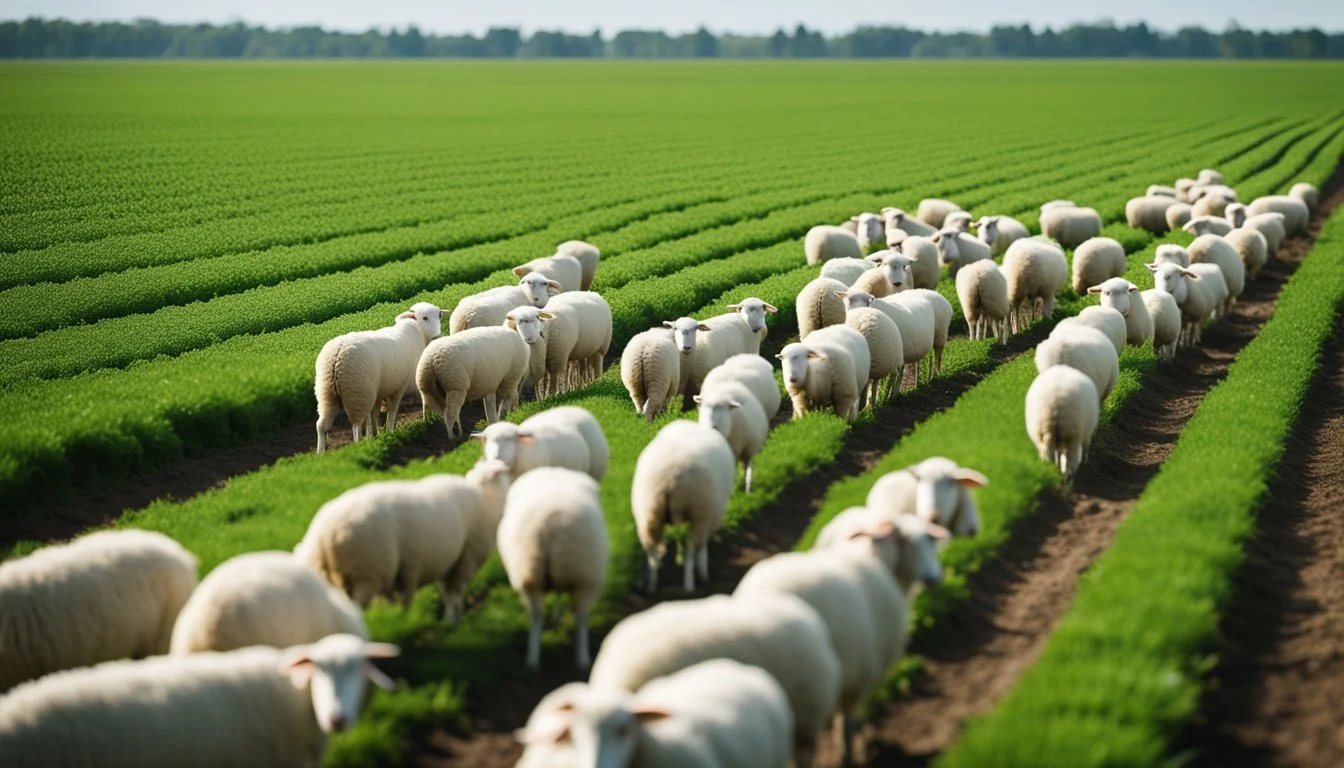6 Baa-ffling Documentaries on the Cloning of Dolly the Sheep
Exploring the Scientific Breakthrough
The cloning of Dolly the sheep in 1996 marked a groundbreaking moment in scientific history. This remarkable achievement by Scottish scientists opened up new possibilities in genetic engineering and sparked intense debates about the ethics of cloning technology.
Dolly's creation captured worldwide attention and inspired numerous documentaries exploring the science, implications, and controversies surrounding animal cloning. These films offer viewers an in-depth look at the fascinating story behind Dolly's birth and the ongoing impact of this scientific milestone on research and society.
1) The Origins of Cloning: Dolly's Predecessors
Cloning experiments date back to the early 20th century. In 1885, Hans Driesch successfully separated sea urchin embryo cells, demonstrating that a single cell could develop into a complete organism.
Robert Briggs and Thomas King made significant progress in 1952. They successfully cloned tadpoles by transferring nuclei from embryonic cells into unfertilized eggs.
John Gurdon's work in the 1960s was groundbreaking. He cloned frogs using adult cell nuclei, challenging the belief that specialized cells couldn't be reprogrammed.
In 1984, Steen Willadsen cloned the first mammal. He produced genetically identical sheep by splitting embryos, though this method differed from the technique used for Dolly.
The 1990s saw rapid advancements. Neal First cloned calves from embryonic cells in 1994, paving the way for more complex mammalian cloning experiments.
These predecessors laid the foundation for the creation of Dolly in 1996, marking a pivotal moment in cloning history.
2) Techniques Behind Dolly's Creation
Dolly's creation involved a groundbreaking technique called somatic cell nuclear transfer. Scientists at the Roslin Institute extracted the nucleus from an adult sheep's udder cell.
They then inserted this nucleus into an enucleated egg cell from another sheep. The resulting embryo was implanted into a surrogate mother sheep.
This process bypassed traditional fertilization, allowing scientists to create a genetic clone. Dolly shared the same DNA as the adult sheep that provided the udder cell nucleus.
The technique required precise timing and careful handling of delicate cellular structures. Multiple attempts were necessary before a successful pregnancy was achieved.
Dolly's birth in 1996 proved that adult cells could be reprogrammed to create a new organism. This challenged the prevailing scientific belief that specialized adult cells couldn't revert to an embryonic state.
The success rate was low, with only 1 in 277 attempts resulting in a live birth. Despite the challenges, Dolly's creation opened new possibilities in genetic research and animal breeding.
3) Ethical Debate: Dolly's Legacy
Dolly the sheep sparked intense ethical debates that continue to shape discussions around cloning and biotechnology. Her birth in 1996 raised profound questions about the boundaries of scientific intervention in nature.
Many observers found the Dolly project deeply troubling. Concerns emerged about the potential for human cloning and its implications for society, identity, and human dignity.
The cloning of Dolly also prompted discussions about animal welfare and the ethics of using animals in scientific research. Critics questioned whether the potential benefits outweighed the risks and suffering involved.
Dolly's creation led to increased scrutiny of biotech advances and their societal impacts. It catalyzed the development of bioethics as a discipline, particularly in Europe, where it often took a skeptical stance towards scientific progress.
The debates surrounding Dolly influenced regulations on cloning research in many countries. Her legacy continues to inform ongoing discussions about emerging biotechnologies and their ethical implications.
4) Impact on Agriculture and Medicine
Dolly's cloning opened new possibilities for agriculture and medicine. In agriculture, cloning techniques allow farmers to replicate animals with desirable traits like high milk production or disease resistance.
Some countries use agricultural cloning to reproduce exceptional specimens, enhancing livestock quality. However, the European Parliament banned animal cloning for food production in 2015 due to ethical concerns.
In medicine, Dolly's creation paved the way for stem cell research and regenerative medicine. Scientists can now create patient-specific stem cells to study diseases and develop personalized treatments.
Therapeutic cloning holds promise for growing replacement tissues and organs. This could potentially solve organ shortages for transplants and treat conditions like Parkinson's disease.
The techniques developed for Dolly also led to advancements in genetic engineering. CRISPR gene editing, for example, builds on cloning technology to modify animal and plant genomes precisely.
5) Interviews with Keith Campbell
Keith Campbell, co-creator of Dolly the sheep, provided valuable insights into the cloning process through various interviews. He discussed the scientific breakthroughs and challenges faced during the experiment.
Campbell emphasized the importance of cellular reprogramming in successful cloning. He explained how they overcame the hurdle of resetting adult cells to an embryonic state, a crucial step in creating Dolly.
In his talks, Campbell addressed ethical concerns surrounding animal cloning. He highlighted the potential benefits in medical research and agriculture while acknowledging the need for responsible application of the technology.
The scientist also shared anecdotes about naming Dolly after Dolly Parton, adding a lighter touch to the groundbreaking research. This personal detail humanized the scientific achievement for the public.
Campbell's interviews often touched on the future possibilities of cloning technology. He speculated on its potential applications in conservation efforts and the production of specialized animals for medical purposes.
Learn more about Keith Campbell's work on Dolly the sheep
6) The Role of Wilmut and His Team
Ian Wilmut led the team of scientists at the Roslin Institute that successfully cloned Dolly the sheep in 1996. As the principal embryologist, Wilmut played a crucial role in developing the nuclear transfer technique used to create Dolly.
Wilmut and his colleagues achieved a groundbreaking feat by cloning the first mammal from an adult somatic cell. This accomplishment sparked global discussions on the ethics and potential applications of cloning technology.
The team's work began with experiments on embryonic cells, successfully producing a pair of lambs in early 1996. They then progressed to using adult cells, culminating in Dolly's birth on July 5, 1996.
Wilmut's announcement of Dolly's creation in February 1997 garnered worldwide attention. The achievement demonstrated that genetic material from specialized adult cells could be reprogrammed to create a new organism.
The success of Wilmut and his team opened up new possibilities in regenerative medicine and stem cell research. Their work laid the foundation for further advancements in cloning and genetic engineering techniques.
Historical Background of Dolly the Sheep
Dolly the sheep was a groundbreaking scientific achievement that revolutionized the field of genetics. Her creation marked a significant milestone in cloning technology and sparked intense ethical debates worldwide.
Early Experiments in Cloning
Scientists had been experimenting with cloning for decades before Dolly's birth. In the 1950s, researchers successfully cloned frogs using embryonic cells. By the 1980s, mammals like mice were cloned from embryonic cells.
The challenge remained to clone an adult mammal. Many scientists believed it was impossible, as adult cells had already specialized into specific functions.
In the early 1990s, researchers at the Roslin Institute in Scotland began exploring new cloning techniques. They aimed to create genetically identical animals for medical research and agricultural purposes.
The Birth of Dolly
On July 5, 1996, Dolly was born at the Roslin Institute. She was created using somatic cell nuclear transfer, a technique that involved transferring the nucleus of an adult sheep's udder cell into an enucleated egg cell.
The process required 277 attempts before success. Dolly's birth was kept secret for months while scientists confirmed her genetic identity.
When announced in February 1997, Dolly made headlines worldwide. She proved that it was possible to clone an adult mammal, challenging long-held scientific beliefs.
Dolly lived for six years at the Roslin Institute, where she gave birth to six lambs through natural mating. Her existence opened new possibilities in stem cell research and regenerative medicine.
Scientific Processes Involved in Cloning
Cloning mammals involves complex scientific techniques that manipulate cellular and genetic material. The process requires precision and specialized equipment to successfully create a genetically identical organism.
Somatic Cell Nuclear Transfer (SCNT)
SCNT is the primary method used in mammalian cloning. Scientists begin by removing the nucleus from an unfertilized egg cell. This enucleated egg is then fused with a somatic cell from the animal to be cloned.
The fusion process typically uses an electric current to combine the cells. Once fused, the egg contains the complete genetic material of the donor animal.
Scientists then stimulate the egg to begin dividing as if it were fertilized. The resulting embryo is implanted into a surrogate mother for gestation.
This technique was used to create Dolly the sheep in 1996, marking a major breakthrough in cloning technology.
Ethical Considerations
Cloning raises significant ethical questions in the scientific community and broader society. Critics argue that it interferes with natural processes and could lead to unforeseen consequences.
There are concerns about the welfare of cloned animals, as many attempts result in failed pregnancies or health issues for successful clones.
The potential for human cloning sparks intense debate. Most countries have banned reproductive human cloning due to ethical and safety concerns.
Therapeutic cloning, which aims to produce stem cells for medical treatments, remains a controversial but active area of research.
Scientists must carefully weigh the potential benefits against ethical implications when pursuing cloning research.
Impact of Dolly's Cloning on Modern Science
Dolly the sheep's successful cloning in 1996 revolutionized scientific research and opened new avenues in biotechnology. This breakthrough led to significant advancements in genetic engineering and stem cell research, paving the way for potential medical treatments and improved understanding of cellular biology.
Advancements in Genetic Research
Dolly's cloning accelerated progress in genetic research. Scientists gained deeper insights into cellular reprogramming and epigenetics. This knowledge proved crucial for developing induced pluripotent stem cells (iPSCs), a major breakthrough in regenerative medicine.
The cloning technique used for Dolly also improved methods for creating genetically modified organisms. This enhanced researchers' ability to study disease mechanisms and test potential treatments in animal models.
Dolly's birth sparked renewed interest in telomere biology. Studies on Dolly and other cloned animals revealed important information about cellular aging processes, contributing to our understanding of age-related diseases.
Long-term Implications for Biotechnology
Dolly's creation had far-reaching effects on the biotechnology industry. It spurred the development of new cloning techniques, leading to advancements in livestock breeding and conservation efforts for endangered species.
The success of Dolly's cloning encouraged further exploration of therapeutic cloning. This research aims to create patient-specific stem cells for treating various diseases, potentially revolutionizing personalized medicine.
Dolly's birth also raised important ethical questions about cloning technology. This led to the establishment of new regulations and guidelines for genetic research, shaping the responsible development of biotechnology.
The cloning breakthrough inspired innovations in drug discovery and testing. Researchers now use cloned cells and tissues to screen potential medications more efficiently, accelerating the development of new treatments.





